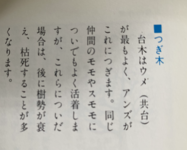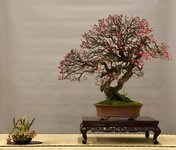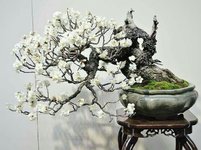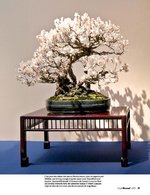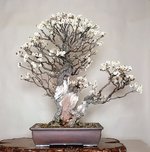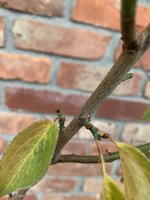I meant to say exactly what I said. I think you skipped post #144 above, which is where I explained in more detail - I am trying to brief here rather than repeating.
There are many moments in an Ume's life when a cultivar can be grafted onto material destined for bonsai, and there are also many locations on the tree where this can be done. In Japan, this can happen decades into a tree's development. For example, while Bjorn was at Kouka-en they took a highly refined 90-year-old Ume and completely swapped its cultivar (and brought it back to Kokufu-level refinement in 5-6 years). Grafting low on young root stock is also common, and it is easily hidden with deadwood. Grafting anywhere onto the primary, secondary, or tertiary branches is also done. Notice that nowhere am I talking about grafting in the "commercially viable way" that it done on Japanese Maples, because I'm talking about what is done at good bonsai nurseries or by specialist bonsai Ume grafters, not garden centres.
Whether or not we are talking about cultivars, grafting is an integral part of developing Ume bonsai. It actually becomes essential on mature specimens, even if you're just taking scions and grafting them further back on the same plant (and you might need to do 20-50 of these in one shot if you are renovating an old ramified specimen). A vast majority of Ume bonsai in Japan start out as 'yardadori', and so as you would imagine such specimens often begin their life as bonsai with a series of grafts (consider esp. the 7th image here).
If we were talking Japanese Maples, I would agree with you (though there are many exceptions). I built a business that has been 75% based on Japanese Maple cutting production... But here we're talking Ume, not Maples, so all
I am asking is that you supply photos that show a high-level Ume cultivar specimen that absolutely had to have been grown on its roots and could not have possibly been grafted. I can't find any! But here are my photos that show where grafts could be easily concealed (but I am not claiming that any of these trees were grafted, I am merely pointing out how grafts can be hidden within the paradigm of Ume aesthetics)

Edit: I also attached an image of some of my sources. The others are people who have worked with Ume bonsai for decades in Japan and beyond. I'm not making this up or giving you my opinion. I am sharing what I learned is done as a matter of fact. If anybody feels to need to innovate, I'd say go for it, but I think Ryan's question really lines things up here: 'What are you trying to achieve?'





